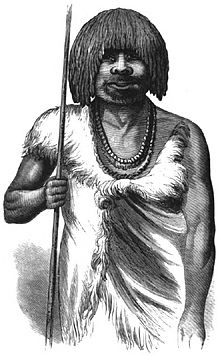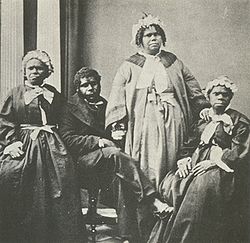Palawa / Pakana / Parlevar | |
|---|---|
 Illustration from The Last of the Tasmanians – Woureddy, Truganini's husband | |
| Regions with significant populations | |
| Tasmania | 6,000–23,572 (self-identified)[1][2][3] |
| Languages | |
| Religion | |
| Christianity; formerly Aboriginal Tasmanian religion | |
| Related ethnic groups | |
| Aboriginal Australians | |

The Aboriginal Tasmanians (Palawa kani: Palawa or Pakana[4]) are[5] the Aboriginal people of the Australian island of Tasmania, located south of the mainland. At the time of European contact Tasmanian Aboriginals were divided into a number of distinct ethnic groups. For much of the 20th century, the Tasmanian Aboriginal people were widely, and erroneously, thought of as extinct and intentionally exterminated by white settlers.[6] Contemporary figures (2016) for the number of people of Tasmanian Aboriginal descent vary according to the criteria used to determine this identity, ranging from 6,000 to over 23,000.[1][2]
First arriving in Tasmania (then a peninsula of Australia) around 40,000 years ago,[citation needed] the ancestors of the Aboriginal Tasmanians were cut off from the Australian mainland by rising sea levels c. 6000 BC. They were entirely isolated from the outside world for 8,000 years until European contact.
Before British colonisation of Tasmania in 1803, there were an estimated 3,000–15,000 Aboriginal Tasmanians.[a] The Aboriginal Tasmanian population suffered a drastic drop in numbers within three decades, so that by 1835 only some 400 full-blooded Tasmanian Aboriginal people survived, most of this remnant being incarcerated in camps where all but 47 died within the following 12 years.[8] No consensus exists as to the cause, over which a major controversy arose.[9] The traditional view, still affirmed, held that this dramatic demographic collapse was the result of the impact of introduced diseases, rather than the consequence of policy.[10] Others attributed the depletion to losses in the Black War,[11] and the prostitution of women.[12][page needed] Many historians of colonialism and genocide consider that the Tasmanian decimation qualifies as genocide by the definition of Raphael Lemkin adopted in the UN Genocide Convention.[13]
By 1833, George Augustus Robinson, sponsored by Lieutenant-Governor George Arthur, had persuaded the approximately 200 surviving Aboriginal Tasmanians to surrender themselves with assurances that they would be protected and provided for, and eventually have their lands returned.[citation needed] These assurances were no more than a ruse by Robinson or Lieutenant-Governor Arthur to transport the Tasmanians quietly to a permanent exile in the Furneaux Islands.[14] The survivors were moved to Wybalenna Aboriginal Establishment on Flinders Island, where disease continued to reduce their numbers. In 1847, the last 47 survivors on Wybalenna were transferred to Oyster Cove, south of Hobart. Two individuals, Truganini (1812–1876) and Fanny Cochrane Smith (1834–1905), are separately considered to have been the last people solely of Tasmanian descent.[b][c]
The complete Aboriginal Tasmanian languages have been lost; research suggests that the languages spoken on the island belonged to several distinct language families. Some original Tasmanian language words remained in use with Palawa people in the (a community of people descended from European men and Tasmanian Aboriginal women on the Furneaux Islands off Tasmania, which survives to the present) and there are some efforts to reconstruct a language from the available wordlists. Today, some thousands of people living in Tasmania describe themselves as Aboriginal Tasmanians, since a number of Tasmanian Aboriginal women bore children to European men in the Furneaux Islands and mainland Tasmania.[1]
- ^ a b c Shine 2017.
- ^ a b Hunt 2017.
- ^ Census probe 2017.
- ^ Berk 2017, pp. 2–20.
- ^ "Aboriginal Tasmanians". www.ourtasmania.com.au. Archived from the original on 12 April 2024.
- ^ Lehman 2006.
- ^ Madley 2008, p. 78, n.7.
- ^ Madley 2008, p. 78.
- ^ Madley 2008, p. 78: "Despite over 170 years of debate over who or what was responsible for this near-extinction, no consensus exists on its origins, process, or whether or not it was genocide".
- ^ Bonwick 1870a, pp. 84–85; Bonwick 1870b, p. 388; Flood 2006, pp. 66–67; Windschuttle 2002, pp. 372–376
- ^ Tatz 2003, p. 79.
- ^ Johnson & McFarlane 2015, p. ?.
- ^ Kiernan 2008, pp. 265ff; Tatz 2003, pp. 78–79; Lawson 2014, pp. 1ff, 31ff.; Madley 2008, p. 104: "In light of the U.N. definition, sufficient evidence exists to designate the Tasmanian catastrophe genocide."
- ^ Boyce 2009, p. 297.
- ^ Ryan 1996, p. 220.
Cite error: There are <ref group=lower-alpha> tags or {{efn}} templates on this page, but the references will not show without a {{reflist|group=lower-alpha}} template or {{notelist}} template (see the help page).